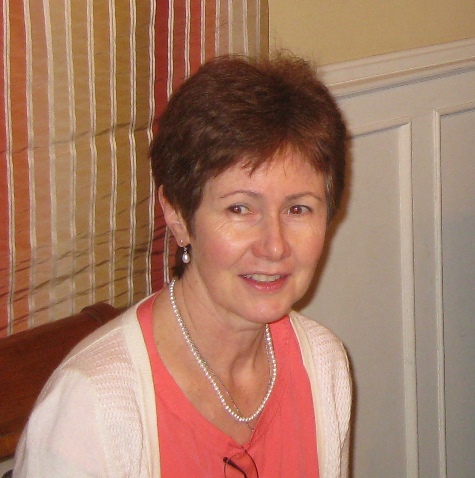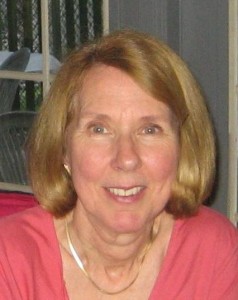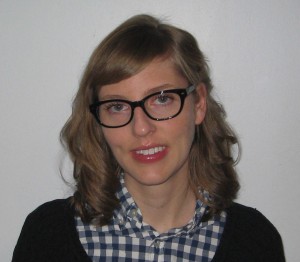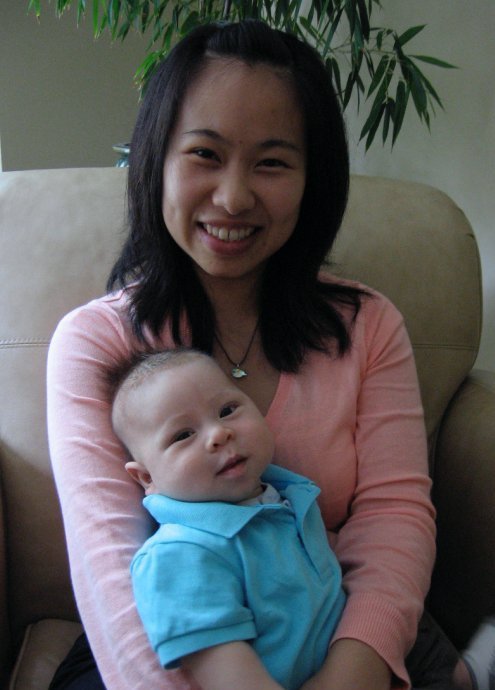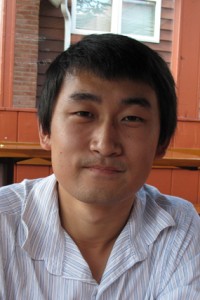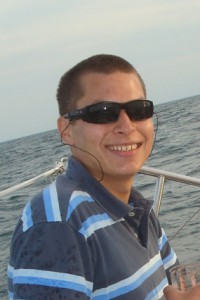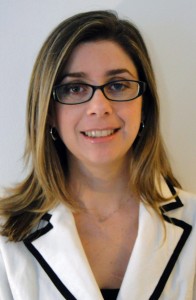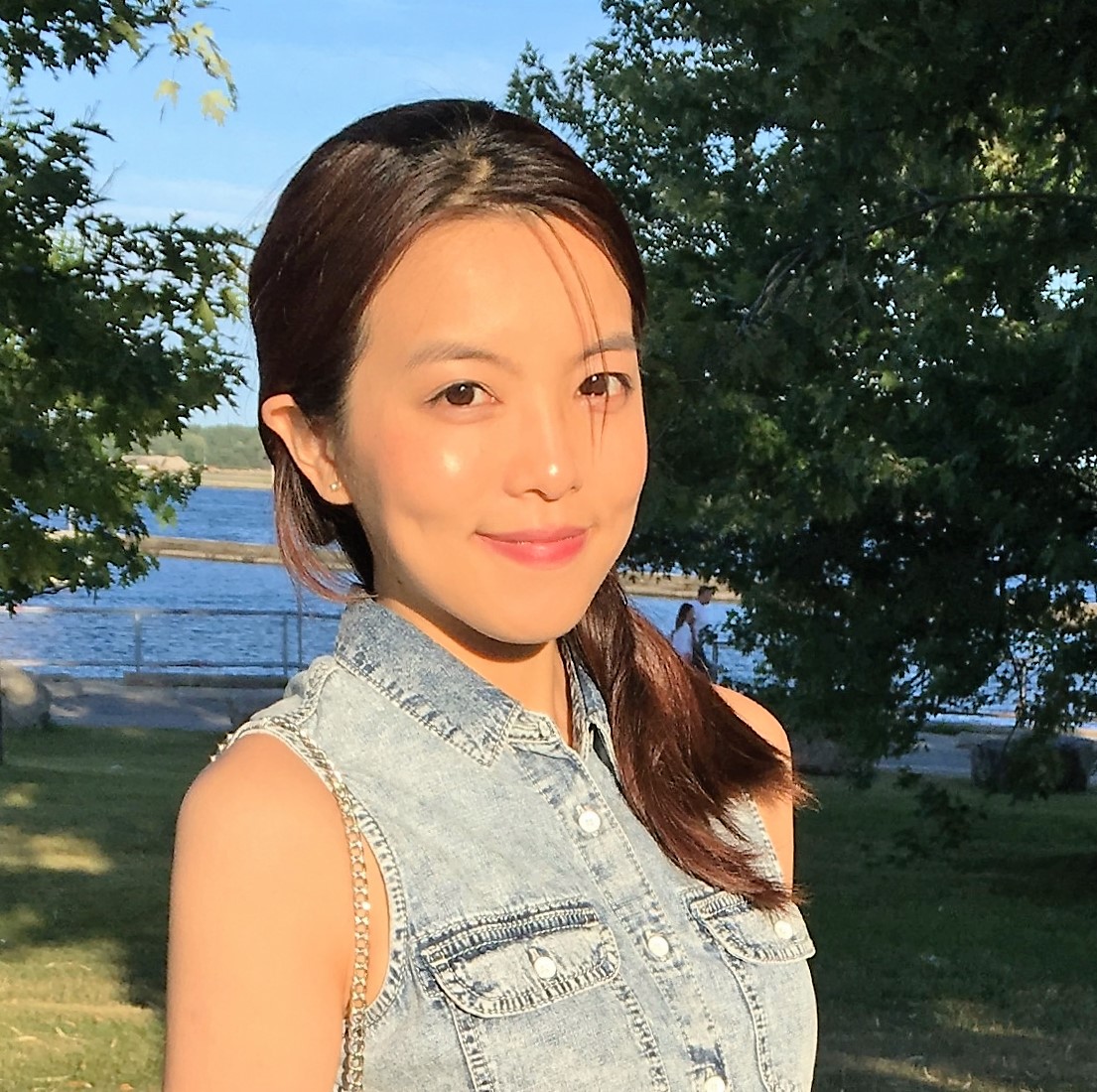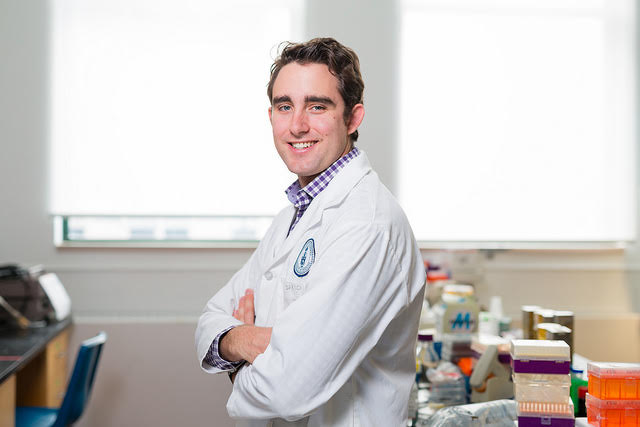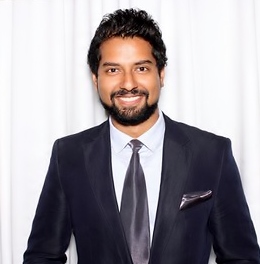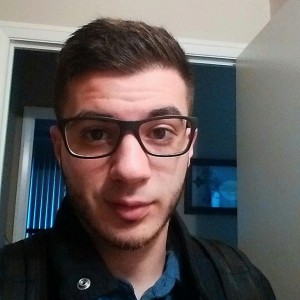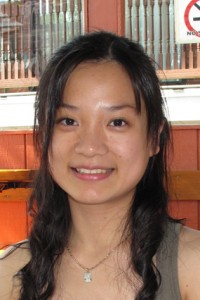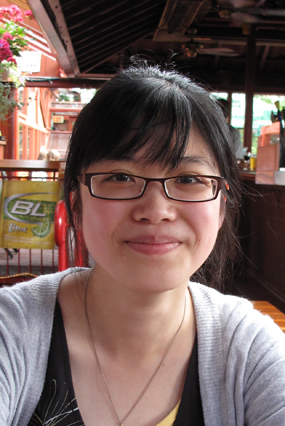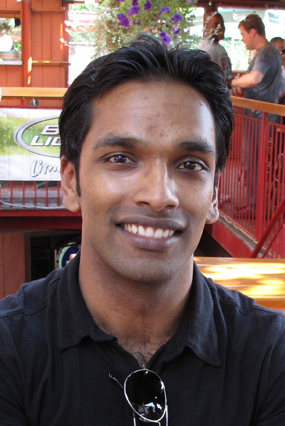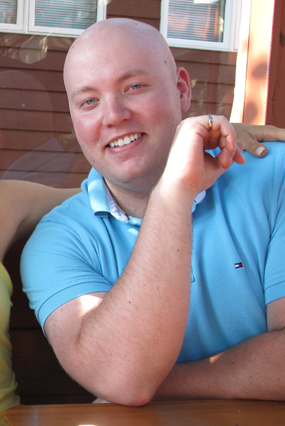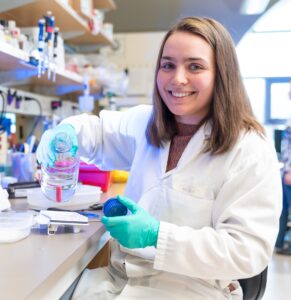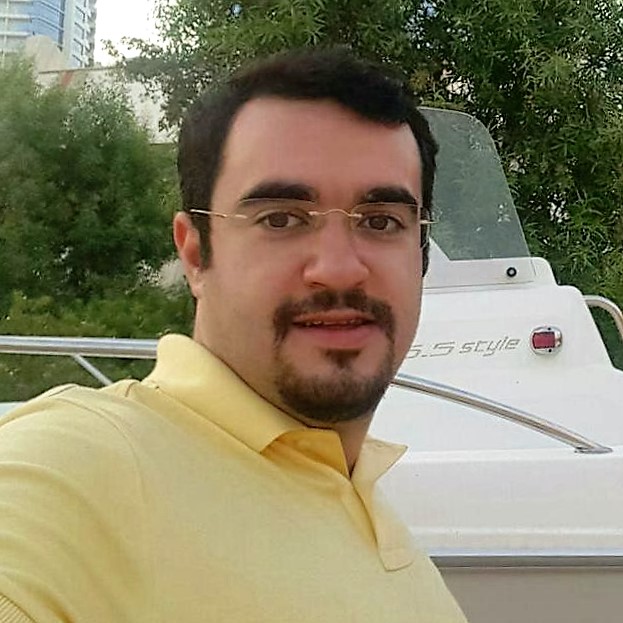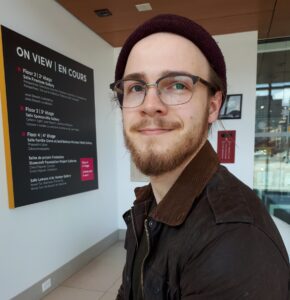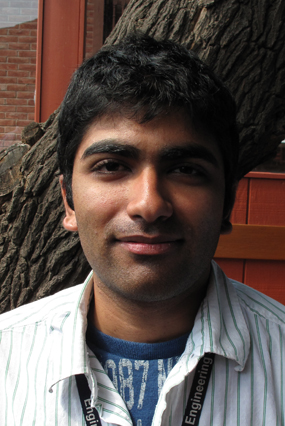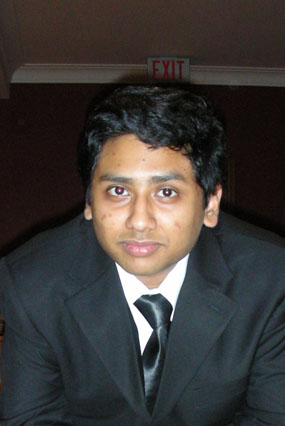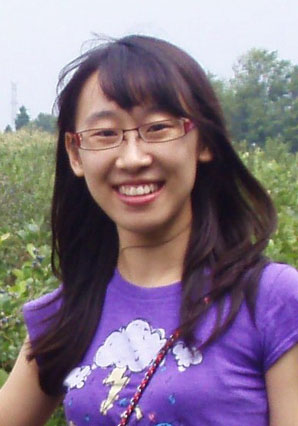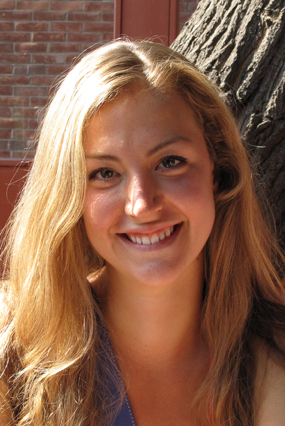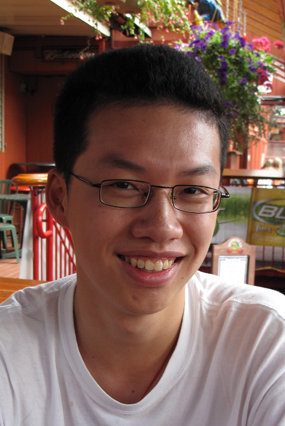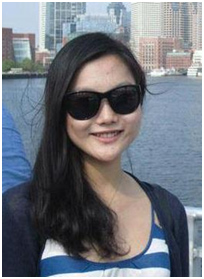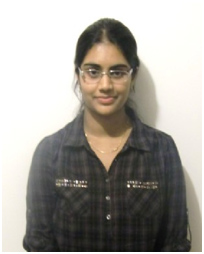Alumni
Research Associates, Lab Technicians: |
||
|---|---|---|
| Elena Bajenova | Elena joined the lab in Mar 2017 as a research associate and has been involved in the culture of IPS cells. In addition she is responsible for the day to day organization and management of the lab including ordering, maintenance of reagent stocks, inventory and biosafety certification. She obtained an PhD in Biochemistry, at the Russian Academy of Sciences. Upon completing her PhD Elena has worked on a wide variety of projects: including the study of ion fluxes in mitochondria, the role of Ca2+- dependent actin filament assembly in PMNs and human gingival fibroblast, discovery of Amelotin, a novel enamel protein, and investigation of the role of V-ATPase in osteoclast differentiation. Most recently she was a research associate with Dr. John Davies assessing the bone bonding to micro- and nano-structured surfaces of titanium implants. |
|
| Carol Laschinger
|
Carol joined the lab in Feb 2012 as a research associate and has been involved in the culture of IPS cells. |
|
| Ericka Knee | Ericka joined the lab in July 2014 as a laboratory research technician. She assisted with writing the laboratory protocols, culturing and passaging stem cells, as well as differentiating human embryonic stem cells into cardiomyocytes for the lab. Furthermore, she helps graduate students with their research projects. Erica received dual bachelor’s degrees with honours in mathematics and chemical engineering with a minor in chemistry from New Mexico Institute of Mining and Technology. In addition, she has a master’s degree in biomedical engineering with an emphasis in biomechanics from Stevens Institute of Technology. Before coming to the lab she worked in a tissue engineering laboratory investigating in vitro 3-D breast cancer tissue models.Erica left the lab in June 2015 to pursue a PhD in the lab of Dr.Boris Hinz. | |
Lan Dang |
||
Larry Meng
|
Larry worked as technician in an active and productive laboratory. He maintained lab and performed the neonatal rat heart isolation and work on the engineered heart tissue by cultivating human embryonic stem cells (hESC). Before joining the lab, he worked at different university-based research institutions and was involved in different research projects such as human heart failure, hypertension, hepatitis C virus in Germany and Canada, respectively. | |
Gordana Jovanovic-Bulajic (2009)
|
||
Post-Docs: |
||
| Dr. Boyang Zhang |
Isolation of pure cell subpopulations and rare progenitor cells from heterogeneous cell suspensions is essential for the advancement of tissue engineering. The purpose of this project is to sort the mixed cell populations in the heart, including fibroblast, cardiomyocytes, endothelial and smooth muscle cells. Microfluidic devices will be developed in this lab to sort cells based on their physical properties such as size and adhesion properties. Boyang completed his PhD in the winter of 2016 and continues to contribute towards research in this lab. Boyang left the lab in June 2018 and is now an Assistant Professor in the Department of Chemical Engineering, McMaster School of Biomedical Engineering, McMaster University |
|
| Dr. Samad Ahadian |
Samad received his Ph.D. in materials science at Tohoku University, Japan in 2011. He was honoured to get the prestigious JSPS doctoral fellowship during his PhD studies. After that, Samad gained 4 years of postdoctoral training in tissue engineering, biomaterials, and stem cell engineering under the supervision of Professor Ali Khademhosseini from MIT-Harvard Medical School, USA. Currently, he is working in the Radisic lab as a research fellow in the area of fabrication of organ-on-a-chip platforms for pharmaceutical and therapeutic applications. Samad left the lab in 2017 to pursue career in industry. |
|
| Dr. Nicole Feric |
Nicole received her Ph.D. in Biochemistry from Queen’s University in December 2011 and joined the lab in January 2012. She characterized the effect of the small peptide QHREDGS, derived from angiopoietin-1, on osteoblast differentiation and bone mineralization. Additionally, she investigated the mechanism by which QHREDGS promotes the adhesion and survival of cardiomyocytes and cardiac fibroblasts, as well as osteoblasts. Nicole took a position as Senior Research Scientist at TARA and has moved to New York City |
|
| Dr. Lewis Reis
|
Lewis graduated from Queen’s University in 2008 with a B.Sc. in Chemical Engineering and after taking a year off to travel came to U of T to pursue his PhD. The main goal of his project is to develop an injectable hydrogel for the treatment of myocardial infarction that will promote the survival, differentiation, and integration of injected cells. So far, work has been done to characterize and show the potential of the developed hydrogel to support cardiomyocytes in-vitro, and progressed to in-vivo trials with a rat myocardial infarction model. Lewis completed his PhD in the spring of 2015 and continued to contribute towards research in this lab. Recently he has taken a consulting position with PWC.. |
|
 Dr. Hannah Song Post Doc Dr. Hannah Song Post Doc |
In adults, the beating heart cells (cardiomyocytes) cannot divide to regenerate the injured or diseased heart; instead they are replaced by a non-beating scar. In several clinical studies, injected cells from the bone marrow or skeletal muscle into the heart have resulted in, at best, modest functional improvement. In all cases, transplanted cell survival has been poor indicating that any beneficial effect is likely to be transient and mediated via mechanisms associated with secreted factors. A major limitation in the development of cellular therapies to the heart is cell survival and integration post transplantation. Therefore, we have developed a model system capable of screening for cell survival and integration into engineered heart tissue (EHT). Our in vitro model system will enable the rapid and efficient screening of candidate cell types and survival / integration factors for pre-clinical studies. Currently, initial studies focus on the survival and integration of embryonic stem cell (ESC)-derived cardiac cells and progenitors into EHT. Our ESC-derived cardiac cells are fluorescently labeled in order to quantitatively track the injected cells into EHT. Once the system is developed, we are planning to pursue screening for factors (small molecules, cytokines) that increase cell survival and integration into cardiac tissue in a high through-put manner. | |
Dario Bogojevic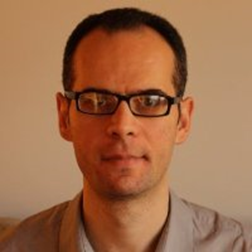 E-mail: d.bogojevic@utoronto.ca |
Dario joined the Laboratory for Functional Tissue Engineering, IBBME in January 2013 as a Postdoctoral Fellow to work on implementation of a new separation technology for label-free enrichment of cardiomyocytes used in research, drug development and cardiac cell therapy. His previous work at the IBBME involves development of Digital Microfluidics technology for multiplexed cell-based assays commonly used in pharmaceutical research.Dario comes from across the Atlantic – born in Sarajevo, he moved to Belgrade where he graduated at the University of Belgrade department of chemical engineering. After one year of working in an oil refinery, he moved again to the UK, in search for more challenges. He obtained his PhD degree at the University of Edinburgh, in the area of microfluidics and heat and mass transfer in micro-scale. Dario left the lab in Sept 2014 to apply his skills at Trojan Technologies, specializing in water treatment. | |
Sara Vasconcelos |
In adults, the beating heart cells (cardiomyocytes) cannot divide to regenerate the injured or diseased heart; instead they are replaced by a non-beating scar. To accelerate a clinical outcome of cardiac cell therapy, we have developed a model system capable of screening for cell survival and integration into engineered heart tissue (EHT). Our in vitro model system will enable the rapid and efficient screening of candidate cell types and survival / integration factors for pre-clinical studies.Currently, we are pursuing screening for factors (small molecules, cytokines) that increase cell survival and integration into cardiac tissue in a high through-put manner. | |
Aarash Sofla
|
Founder CEO of uFluidix, a Toronto company that manufactures microfluidic chips. | |
PhD: |
||
| Dr. Erika Wang
E-mail: erikayan.wang@mail.utoronto.ca |
Erika received her MSc in Physiology from the University of Manitoba, where she investigated molecular pathways involved in heart failure under Dr. Lorrie Kirshenbaum’s supervision. After working on a stem cell project at the Thoracic Surgery Research Division of University Health Network, she joined the Radisic lab in 2016 to pursue her PhD in Biomedical Engineering. Her research will focus on the regeneration of functional cardiac tissues from human pluripotent stem cells (hPSC) and human embryonic stem cells (hESC), and the development of engineered tissue for pharmaceutical and therapeutic applications. | |
| Dr. Locke Davenport Huyer
E-mail: l.davenporthuyer@mail.utoronto.ca |
Locke graduated in June 2014 with a degree in Chemical Engineering from Queen’s University. The characteristics of biomaterials used in tissue engineering scaffolds are designed to mimic the properties of the host tissue and degrade to allow for the integration of engineered tissues. Locke is investigating the design of a biodegradable polymer that will satisfy these requirements and elicit a minimized immune response when integrated into functional tissue engineering applications. Locke completed his PhD in the summer of 2019 and continues to work in the Lab. | |
| Dr. Nimalan Thavandiran
E-mail:nimalan.thavandiran@utoronto.ca |
Nimalan was designing stimulatory/sensory microbioreactor screening systems for investigating the mechanisms by which human Pluripotent Stem Cells (hPSC) differentiate into mature, adult-like cardiomyocytes within three-dimensional microenvironments (via cell-cell and cell-ECM interactions), and then how they proceed into disease-states caused by Myocardial Infarction (MI). The complex process by which hPSC fate toward a mature and functional heart cell is determined, all the while mediated by biochemical, mechanical, and electrical stimuli, each of which uniquely interact temporally and spatially to induce signaling cues and morphogenesis, still remains elusive. Additionally, it has proven difficult to accurately recapitulate MI *in vitro* through induction of the same apoptosis signaling pathways as observed *in vivo*. The goal is to use this microtissue-based high-content screening platform to discover and validate the efficacy and safety of novel small molecules which may be beneficial as cardioprotectants, anti-arrhythmogenics, and promoters of regeneration after MI. He graduate in August 2019. | |
| Miles Montgomery
|
In June 2012 Miles completed a double major with honours in chemical and biological engineering from McMaster University. One of the key challenges in the field of tissue engineering is the inability to supply in vivo levels of oxygen and nutrient delivery and waste removal to cells in an in vitro environment. These mass transport limitations restrict the current thickness of engineered devices. In many tissue engineering applications (including the heart) the thickness must be increased in order for the devices to become truly functional. Miles investigated new approaches to overcome these current confines in hopes of developing ways in which efficient mass transport can be achieved in tissue engineered devices. Miles took a leave to pursue a career in a biotechnology company he co-founded- MagniWare Ltd., he completed his PhD in 2018 and pursues career in industry |
|
| Robert Civitarese
|
Despite advances in medical therapy, including neuro-hormonal blockade, use of cardiac resynchronization therapy and surgical procedures, mortality from heart failure remains unacceptably high, at ~25.2% per year. More than two-thirds of heart related deaths are attributable to coronary artery disease, a blockage in a heart vessel causing a myocardial infarction (MI). Lack of blood flow (ischemia) results in cardiac cell death and leads to the formation of a fibrotic scar, ultimately impairing normal cardiac function. Currently, no clinical therapeutic exists to stimulate repair of the ischemic heart tissue. Robert is doing his PhD portion of his combined MD / PhD degree investigating ways of improving the electrophysiological integration and maturation of a cardiac patch, with the ultimate goal of limiting cardiac cell death and improving cardiac function following an MI. Rob has left the lab and is now working on his MD degree |
|
| Iran Rashedi E-mail: i.rashedi@utoronto.ca |
I have obtained a MD degree from Tehran Univ and completed a MSc program in Dep of Biochemistry and Medical Genetics, Univ of Manitoba. Currently, I am doing a PhD, studying the regenerative potential of stem/progenitor cells including bone marrow mesenchymal stromal cells in cardiovascular context. I like and play racquet sports, and enjoy biking on weekends. Congratulations to Iran who successfully defended her PhD in Dec 2016 |
|
Aric Pahnke E-mail: aqpahnke@gmail.com |
Aric is pursuing a doctorate in Chemical Engineering and Applied Chemistry while participating in the Collaborative Program in Biomedical Engineering. He graduated in Biomedical Engineering from the University of Utah and joined this group in 2012. His work was focused in the area of recreating cardiac tissues in vitro from pluripotent stem cells that are similar in maturity and function to the native heart. He is now pursuing other interests. | |
| Yun(Jo) Xiao
|
Yun was a PhD student in the Chemical Engineering and Biomedical Engineering Collaborative Program. Her research focused on biomaterials for cardiac tissue engineering.Jo completed her PhD in Feb of 2016 and has returned to China to pursue her academic and research career. |
|
| M.Y. Anne Hsieh
|
Anne pursued a Ph.D. in the joint Chemical and Biomedical Engineering at the University of Toronto after receiving her undergraduate degree in Chemical Engineering with minor in Biology and options in Management Science and Statistics, from the University of Waterloo. Her research focuses on designing microfluidic devices for cell selection. Anne has received several scholarships including URSA, CGS-M, and CGS-D from NSERC, U of T fellowships from Chemical Engineering, and Mary H. Beatty. As a teaching assistant, she has supervised engineering courses including Biotransport Phenomena (CHE393) and Engineering Biology (CHE353) in 2008-2012, and as course instructor for DEEP Summer Academy (Genetic Engineering). Anne completed her PhD in the summer of 2015 . |
|
| Dr. Loraine Chiu |
Loraine Chiu received her Bachelor’s degree with honours from the Department of Chemical Engineering at the University of Toronto in June 2007, with a minor in Bioengineering and the completion of a fourth year undergraduate thesis project on the combined effect of non-myocytes co-culturing and electrical stimulation for cardiac tissue engineering. As a recipient of NSERC CGS-M (2007-2009), she worked under the supervision of Dr. Milica Radisic for her Masters thesis project to investigate the effects of vascular endothelial growth factor and angiopoietin-1 on angiogenesis. After graduating in March 2009, she continued her studies in the LFTE group. As supported by NSERC CGS-D (2009-2011) and Queen Elizabeth II Graduate Scholarship in Science and Technology (2011-2012), she worked on her PhD thesis project involving angiogenesis in scaffolds and injectable biomaterials for cardiac repair. She successfully defended her PhD thesis and graduated in August 2012. After graduating with her Ph.D. degree in 2012, Loraine received the NSERC postdoctoral fellowship and started working under Dr. Mick Bhatia in the Stem Cell and Cancer Research Institute at McMaster University. |
|
Rohin Iyer
|
Rohin Iyer was the first student at LFTe and obtained his Ph.D in 2012. He was instrumental in helping to setup the Laboratory for Functional Tissue Engineering in 2005 and has trained many of Dr. Radisic’s graduate students. His project at LFTe dealt with cell tri-culture in microbioreactor systems for cardiac tissue engineering as well as scale up to mesoscale cardiac patches in bioreactors in animal models of myocardial infarct. He also worked as a visiting scientist under the guidance of Dr. Radisic’s former advisor, Dr. Gordana Vunjak-Novakovic, at the Department of Biomedical Engineering at Columbia University, New York. Rohin has significant experience in the areas of regenerative medicine, tissue engineering, bioreactor design and fabrication, microfabrication and soft lithography, cell tracking, animal surgery, and stem cell bioengineering methodologies. He is now employed as a Research Scientist at Tissue Regeneration Therapeutics Inc., a progressive biotechnology company based in Toronto, Canada, where he is doing work with umbilical cord-derived mesenchymal stem cells for regenerative medicine applications. http://research.rohiniyer.com. | |
Nik Jewell
|
||
Katherine Chiang  |
The main goal of Katherine’s project is to engineer a blood vessel by site specific differentiation of Flk1+ (or KDR+) vascular progenitors on substrates with immobilized VEGF or PDGF-BB. |
|
Masters: |
||
| Katrina Vizely
E-mail: katrinavizely@gmail.com |
Katrina graduated with a degree in Biochemistry from the University of Victoria. Her thesis project focused on the functionalization of bacteriophage for high-throughput screening of inhibitors for application in drug discovery. Other previous experience included working in Agriculture and Cancer Research. She joined the lab in September of 2019 to pursue a PhD in Chemical Engineering. Her project will investigate the direct and indirect effects of a bioactive peptide on keratinocytes and immune cells in the context of wound healing. |
|
| Mohammad Hossein Mohammadi
E-mail: maosein@gmail.com |
Mohammad received his B.S in Chemical Engineering from Sharif University of Technology. He joined the Radisic lab on September 2016 to pursue his PhD in a collaborative program between Chemical Engineering and Biomedical Engineering. His is currently researching the separation of carbon nanotubes from cardiomyocytes after enhancing their differentiation and maturation using a microfluidic device. |
|
Hadel Al Asafen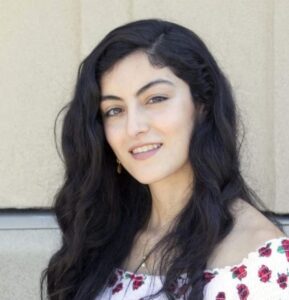
E-mail:hadel.alasafen@utoronto.ca |
Hadel graduated from North Carolina State University with a Master’s degree in Chemical and Biomolecular Engineering and a minor in Biotechnology. She joined our lab in 2019 to pursue her PhD in Chemical Engineering with a collaborative specialization in Biomedical Engineering. Her research project includes a collaboration with Prof. Gordana Vunjak-Novakovic’s lab at Columbia University in New York. She is working on developing personalized heart-on-a-chip model to advance personalized regenerative medicine. When she is not doing heart stuff, she enjoys volunteering, traveling, and learning languages. | |
| Joshua Yazbeck
|
Josh received his degrees in Biotechnology (B.A.Sc. Chemical Engineering and B.Sc. Biochemistry) at the University of Ottawa, where he designed and modelled a bioreactor for cartilage tissue engineering. He joined the lab in Fall 2019 with the goal of pursuing his PhD in Chemical Engineering and Applied Chemistry. He will be working on developing stimulation protocols including heart rate variation, and understanding the mechanisms of cardiac maturation by electrical stimulation in vitro. | |
Devang Odedra (2007-2008)
|
Devang has received his BASc. from the Engineering Science program (specialization in Biomedical Engineering) from the University of Toronto. Currently, he is working on his Master’s project of directing endothelial cell growth on collagen scaffolds by means of immobilized protein gradients. He has developed three methods of macroscopic gradient generation in collagen scaffolds and is currently investigating the effect on endothelial cells. Through his project, he hopes to achieve better cell survival in engineered heart patches. | |
Fiona Rask (2007-2009)
|
Fiona Rask received her Bachelor’s degree with honours from the Department of Chemical Engineering at Queen’s University in June 2007. As a recipient of an NSERC CGS-M, she is currently pursuing a Master’s degree in the Laboratory for Functional Tissue Engineering under the supervision of Dr. Milica Radisic. Her thesis is investigating an injectible hydrogel for cardiomyocyte delivery into the heart. Fiona has previously received two NSERC URSAs, which were used to work at Queen’s University, one year in a physical chemistry lab and the following year at the Human Mobility Research Centre in a cartilage tissue engineering lab. In the proceeding school year, she continued her work in cartilage tissue engineering to complete her fourth year undergraduate thesis, studying the effects of antioxidants on the growth of cartilage tissue. | |
Melissa Brown (2006-2009)
|
Melissa obtained her B.A.Sc from the Biomedical Engineering option of Engineering Science at the University of Toronto (Class of 0T6). Her 4th year thesis research was done on Perfusion Bioreactor Systems for Cardiac Tissue Engineering, under the supervision of Dr. Milica Radisic. This research seeks to improve the functionality and thickness of polymer-based cardiac patches by varying bioreactor conditions. She is currently working in the Radisic lab as a summer student, continuing her thesis research. | |
Heidi Au (2006-2009)
|
Heidi Au received a Bachelor’s degree with honours from the Department of Chemical Engineering at the University of Toronto in June 2006. Over the summer of 2006, she investigated the effect of contact guidance and electrical stimulation on myocardium cells. As a recipient of a U of T Open Fellowship, she is currently pursuing a Master’s degree and her project involves the characterization of a cardiac progenitor population within the neonatal rat heart. Heidi’s previous research experiences include stem cell work as well as wastewater treatment. Her undergraduate thesis, which focused on the study of genes involved in stem cell self-renewal and differentiation, was supervised by Dr. William L. Stanford. Heidi is also an active member of student clubs such as the Chemical Engineering Graduate Student Association (CEGSA) and Leaders of Tomorrow program at the University of Toronto. In fall 2005, she was part of the Student Program Organizing Committee for the Canadian Society for Chemical Engineering (CSCh | |
Fahad Chowdhury (2006-2009)
|
Fahad received his B.A.Sc (Hon) from the Engineering Science Program (Biomedical Option) at the University of Toronto, and was a graduate of the Class of OT6. His undergraduate thesis was titled “Engineering surfaces to enable the patterning of stem cells”, where he worked under the supervision of Dr. Zandstra at the Stem Cell Bioengineering Lab. His present M.A.Sc. project will involve the patterned localization of the growth factor VEGF, to enable site-specific differentiation of mesodermal progenitor cells to endothelial cells or smooth muscle cells. Such a technology will allow for the development of cardiac patches flanked by vessels made of endothelial and smooth muscle cells. Outside of the lab, Fahad is an executive member of the Biomedical Engineering Student Association (BESA) and a member of the Biomedical Engineering Society (BMES) Toronto Chapter. | |
Mark Li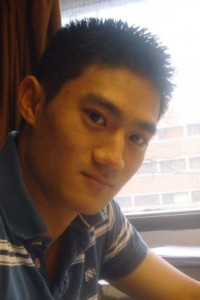 |
When embryonic stem cells (ESCs) are put in contact with cardiomyocytes (CMs), they improve the survival rate of CMs. Previous study showed that this effect only takes place when ESCs are brought into direct contact with the CMs. Mark’s project is to inject fixed ESCs onto CMs to reproduce this effect. Should this happen, he will then isolate the membranes of the ESCs and attempt to identify the substrate causing this effect. |
|
Jason Miklas (2012-2014)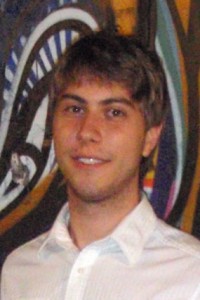 |
Jason was a Master’s student in the laboratory for functional tissue engineering. He completed his bachelor’s degree at the University of Toronto in Materials Science Engineering with a minor in Bioengineering and an option in nanomaterials. He worked on understanding how mechanical and electrical stimulation of hESC-CMs affected their maturation. He is currently pursuing a PhD in bioengineering at the University of Washington in Seattle. Jason is working for Professor Hannele Ruohola-Baker, studying how microRNAs are able to regulate stem cell derived cardiomyocyte maturation. |
|
Genna Conant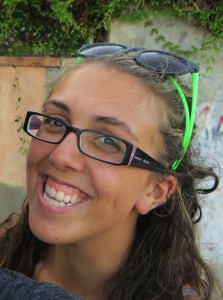 E-mail: gconant91@gmail.com |
Genna graduated with honours from McMaster University in 2014 with a bachelor’s degree in Chemical Engineering and Bioengineering. She recently joined the lab and has started her Master’s degree in the Chemical Engineering and Biomedical Engineering Collaborative Program. Her research investigated the use of engineered cardiac tissues as an in vitro drug testing platform. She defended her Masters in Feb 2017 and is currently employed as an intern with Hammock Therapeutics. |
|
Undergraduate Students: |
||
Shahed Al-Haque
|
Shahed is a fourth year undergraduate student in Engineering Science majoring in Biomedical Engineering. He is completing his fourth year thesis in the LFTE. Shahed research involves investigating the effect of environmental mechanical properties and micropatterning on the alignment and elongation of cardiomyocytes. Previous studies have focused on micropatterning cardiomyocytes in two dimensional substrates. While such studies are constructive, ultimately their veracity falls into question as they do not accurately represent the three dimensional native environment. The goal of Shahed’s project is to direct 3D alignment and elongation of cardiomyocytes and assess their functional properties in a hydrogel of optimal mechanical properties. To learn more about the project, please feel free to contact Shahed directly. | |
Yan Liang
|
Yan is a fourth year undergraduate student in Chemical Engineering. For her undergraduate thesis project, she will work with Loraine to evaluate the use of injectable biomaterials to promote vascularization and angiogenesis. The goal of the project is to optimize vascularization and the alignment of the endothelial and smooth muscle cells. | |
Katrina Janic (2009-2010)
|
The main goal of Katarina’s project is to develop an oriented 3D cultures of cardiomyocytes using hydrogels and electrical stimulation. | |
Kent Huynh (Summer 2010)
|
Kent is working with Lewis on the project of developing injectable hydrogels, to replace those damaged by myocardial infarction. Specifically, the objective is to determine if these gels are capable of increasing survivability of cardiomyocytes and mechanically stable to withstand the beating of the heart. Kent is also investigating the effect of the angiopoietin-1 derived peptide QHREDGS to promote cardiomyocyte attachment and growth. | |
Zane Chu (2007-2008) |
Zane Chu is a fourth year student in the Biomedical Engineering option of Engineering Science. He is currently working with Heidi Au to characterize a cardiac progenitor cell population in neonatal rat hearts. Specifically, his fourth year thesis is a study of the transcriptional profile of these cardiac progenitors over time using RT-PCR. His previous research experience includes work in fast PCR, microarray genotyping and single nucleotide polymorphisms at the UBC iCAPTURE Centre under Dr. Scott Tebbutt. | |
Bashir Bhana (2007-2008) |
Bashir Bhana is a fourth year student in Chemical Engineering. He is currently working with Rohin Iyer to characterize the effect of substrate stiffness on the phenotype of cardiomyocytes. His previous research experience includes investigating novel techniques for the quantification of catecholamine content (for example, adrenaline) in the blood of newborn infants under Dr. Azar Azad and Dr. Kenneth Pritzker at Mount Sinai Hospital. Bashir is also the President of the Club for Undergraduate Biomedical Engineering at the University of Toronto. | |
| Lara Fu |
Lara is a summer and thesis student from Engineering Science (Biomedical) department. She is currently working on projects related to iPS cells in cardiac tissue engineering. |
|
| Kujaany Kana |
Diabetic patients show dysfunction of CMs independent of MI indicating that diabetes directly affects CMs. However, the underlying mechanisms are not fully understood, and developing a diabetic CM test-bed could enable drug screening studies specific to the diabetic heart. In our previous studies, diabetic cardiac conditions were mimicked by cultivating neonatal rat CMs seeded onto collagen scaffolds in normal or high glucose with or without insulin. Interestingly, the application of electrical field stimulation enhanced electrical excitability parameters and the cell morphology in the high glucose group similar to the application of insulin. The beneficial effects of electrical field stimulation on engineered cardiac tissue were known to us from previous studies, however the underlying molecular mechanisms were yet to be elucidated. The goal of Kujaany’s project will be to elucidate the pathways involved in these responses. Specifically, she will investigate the phosphorylation of PI3 kinase, AKT and MAPK under different conditions. |
|
Yi-Hao Alex Shen (2006-2007) |
Alex was a fourth year undergraduate student in engineering science biomedical option. His undergraduate thesis focused on immobilization of growth factors for cardiac tissue engineering. He can be contacted at yihao.shen@utoronto.ca. | |
Filip Marinkovic (Summer 2006, 2007) |
||
Jane Chui (Summer 2007) |
||
Ying Meng (Summer 2007) |
||
Irene Cheng (2005-2006) |
Irene’s project investigates the effect of contact guidance and electrical stimulation on cardiac fibroblasts and myocytes that are cultured on vinyl coverslips. The objective is to imitate the structure and behaviour of cardiac cells in the native heart, which are characterized by cell elongation, alignment and synchronous contractions to electrical input. Contact guidance is a mechanical method of aligning cardiac cells by creating microabrasions on the surface of the vinyl coverslips. The role of electrical stimulation is to assess the contractile function of the myocytes and may be used to align fibroblasts and myocytes. | |
Sasha Kucharczyk (Summer 2005) |
||
Volunteers: |
||
Mena Gewarges (2008-2009) |
||
Work-Study Students
Anne Fu (2013-2014), Lana Ran Du (2014-2015)
Julia Antolovich (2015-2016)
